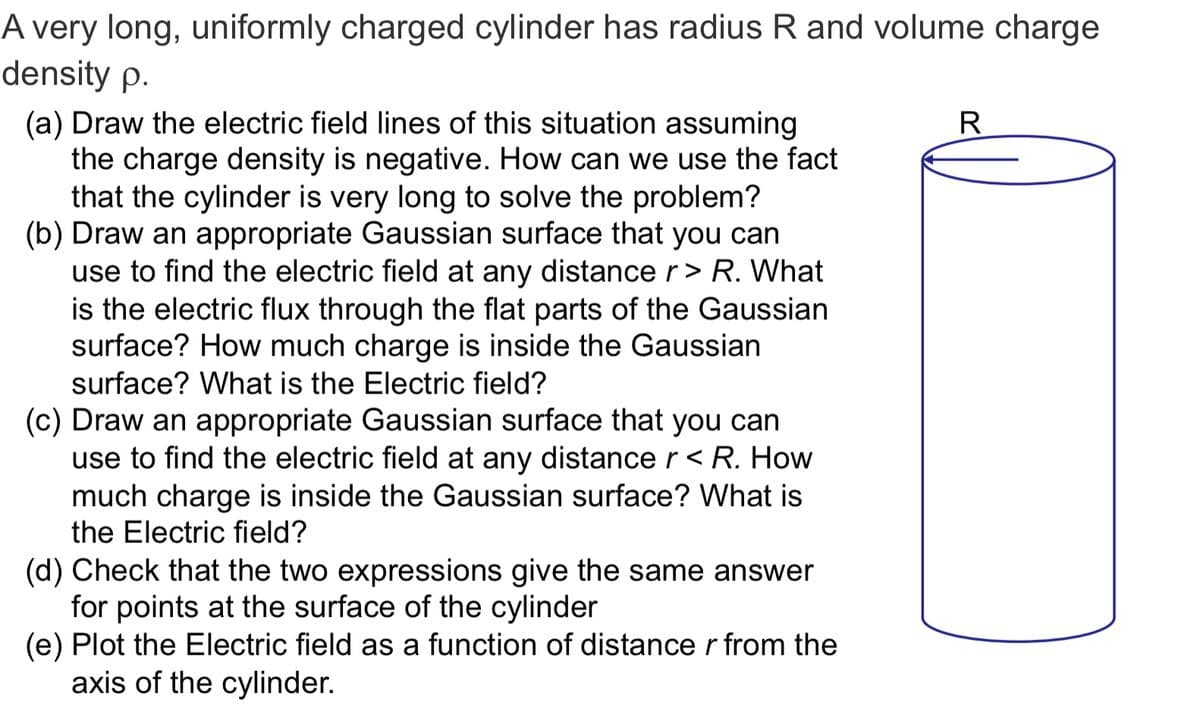A very long, uniformly charged cylinder has radius R and volume charge density p. (a) Draw the electric field lines of this situation assuming the charge density is negative. How can we use the fact that the cylinder is very long to solve the problem? (b) Draw an appropriate Gaussian surface that you can use to find the electric field at any distance r> R. What is the electric flux through the flat parts of the Gaussian surface? How much charge is inside the Gaussian R surface? What is the Electric field? (c) Draw an appropriate Gaussian surface that you can use to find the electric field at any distance r< R. How much charge is inside the Gaussian surface? What is the Electric field? (d) Check that the two expressions give the same answer for points at the surface of the cylinder (e) Plot the Electric field as a function of distance r from the axis of the cylinder.
A very long, uniformly charged cylinder has radius R and volume charge density p. (a) Draw the electric field lines of this situation assuming the charge density is negative. How can we use the fact that the cylinder is very long to solve the problem? (b) Draw an appropriate Gaussian surface that you can use to find the electric field at any distance r> R. What is the electric flux through the flat parts of the Gaussian surface? How much charge is inside the Gaussian R surface? What is the Electric field? (c) Draw an appropriate Gaussian surface that you can use to find the electric field at any distance r< R. How much charge is inside the Gaussian surface? What is the Electric field? (d) Check that the two expressions give the same answer for points at the surface of the cylinder (e) Plot the Electric field as a function of distance r from the axis of the cylinder.
Chapter6: Gauss's Law
Section: Chapter Questions
Problem 86AP: Two non-conducting spheres of radii R1 and R2 are uniformly charged with charge densities p1 and p2...
Related questions
Question

Transcribed Image Text:A very long, uniformly charged cylinder has radius R and volume charge
density p.
(a) Draw the electric field lines of this situation assuming
the charge density is negative. How can we use the fact
that the cylinder is very long to solve the problem?
(b) Draw an appropriate Gaussian surface that you can
use to find the electric field at any distance r> R. What
is the electric flux through the flat parts of the Gaussian
surface? How much charge is inside the Gaussian
surface? What is the Electric field?
R
(c) Draw an appropriate Gaussian surface that you can
use to find the electric field at any distance r < R. How
much charge is inside the Gaussian surface? What is
the Electric field?
(d) Check that the two expressions give the same answer
for points at the surface of the cylinder
(e) Plot the Electric field as a function of distance r from the
axis of the cylinder.
Expert Solution
This question has been solved!
Explore an expertly crafted, step-by-step solution for a thorough understanding of key concepts.
This is a popular solution!
Trending now
This is a popular solution!
Step by step
Solved in 4 steps with 4 images

Recommended textbooks for you

